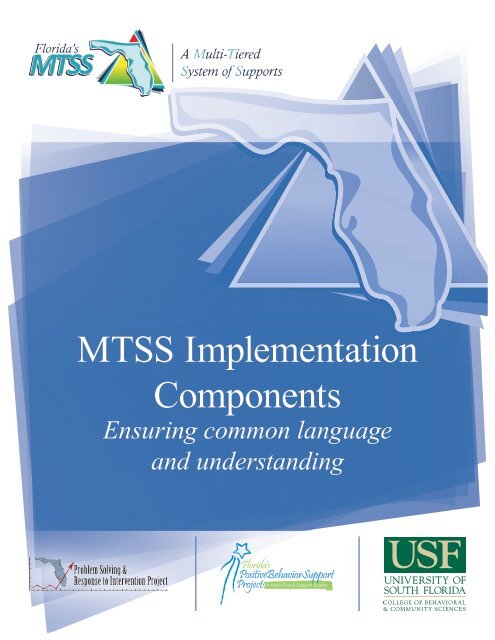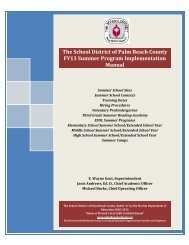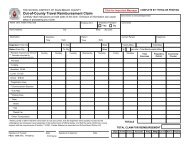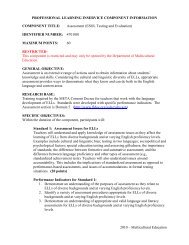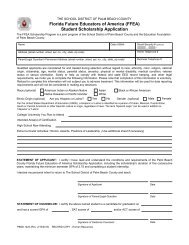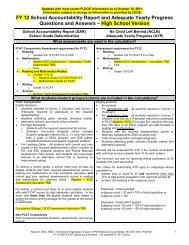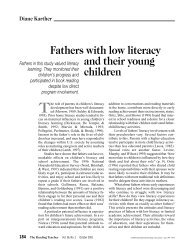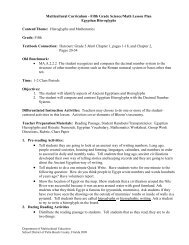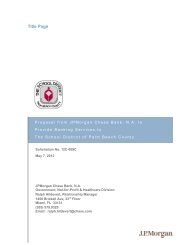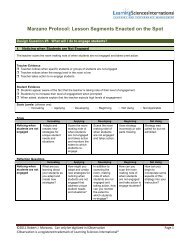MTSS - Florida's Multi-Tiered System of Supports
MTSS - Florida's Multi-Tiered System of Supports
MTSS - Florida's Multi-Tiered System of Supports
Create successful ePaper yourself
Turn your PDF publications into a flip-book with our unique Google optimized e-Paper software.
<strong>MTSS</strong> Implementation<br />
Components<br />
Ensuring common language<br />
and understanding
Table <strong>of</strong> Contents<br />
Common Questions about <strong>MTSS</strong> Page #<br />
<strong>Multi</strong>-tiered systems <strong>of</strong> supports defined<br />
What are the basic components <strong>of</strong> the problem-solving process?<br />
2<br />
3<br />
How do we define Tiers 1, 2, and 3? 3<br />
How do we differentiate Tiers 1, 2, and 3? 4<br />
What does “instruction” look like in Tiers 1, 2, and 3? 4<br />
What does assessment look like in Tiers 1, 2, & 3? 5<br />
What is “fidelity” and how is it assessed? 7<br />
How do we ensure fidelity <strong>of</strong> instructional/intervention services across the<br />
Tiers?<br />
What are “decision-rules” and how are they connected with assessing<br />
effectiveness <strong>of</strong> instruction/intervention?<br />
What are the critical elements <strong>of</strong> the district and school infrastructure that<br />
must be in place to implement and sustain <strong>MTSS</strong>?<br />
What are the skills and activities that best define the role <strong>of</strong> “coaching” within a<br />
<strong>MTSS</strong>?<br />
What are the sets <strong>of</strong> skills required <strong>of</strong> a principal and what activities best define<br />
the role <strong>of</strong> a principal?<br />
What are the most important or highest priority elements <strong>of</strong> a program<br />
evaluation model?<br />
What are some likely reasons that implementation succeeds or fails at either<br />
the district or school levels?<br />
8<br />
9<br />
9<br />
10<br />
11<br />
11<br />
12
<strong>Multi</strong>-<strong>Tiered</strong> <strong>System</strong> <strong>of</strong> <strong>Supports</strong> (<strong>MTSS</strong>) Implementation Components<br />
Common Questions<br />
<strong>Multi</strong>-<strong>Tiered</strong> <strong>System</strong> <strong>of</strong> <strong>Supports</strong> (<strong>MTSS</strong>) Defined:<br />
A <strong>Multi</strong>-<strong>Tiered</strong> <strong>System</strong> <strong>of</strong> <strong>Supports</strong> (<strong>MTSS</strong>) is a term used to describe an evidencebased<br />
model <strong>of</strong> schooling that uses data-based problem-solving to integrate academic and<br />
behavioral instruction and intervention. The integrated instruction and intervention is<br />
delivered to students in varying intensities (multiple tiers) based on student need. “Needdriven”<br />
decision-making seeks to ensure that district resources reach the appropriate<br />
students (schools) at the appropriate levels to accelerate the performance <strong>of</strong> ALL students<br />
to achieve and/or exceed pr<strong>of</strong>iciency.<br />
Many existing terms and initiatives share the common elements <strong>of</strong> data-based<br />
problem-solving to inform instruction and intervention (e.g., Positive Behavior Support<br />
[PBS], Problem Solving/Response to Intervention [RtI], Continuous Improvement Model<br />
[CIM], Lesson Study, Differentiated Accountability). Although several initiatives share this<br />
core characteristic <strong>of</strong> data-based problem-solving, the differences in the use <strong>of</strong> terms (i.e.,<br />
the labels used to describe them), who has responsibility for implementing data-based<br />
problem-solving (e.g., general education, special education, student services), and the<br />
language used to describe the initiatives have <strong>of</strong>ten resulted in high levels <strong>of</strong> variability in<br />
the implementation <strong>of</strong> the model at state, district and school levels. These differences serve<br />
to potentially limit the impact <strong>of</strong> this model on both the integrity <strong>of</strong> implementation and on<br />
student growth.<br />
The primary function <strong>of</strong> district leadership is to 1) ensure that a common-language,<br />
common-understanding exists around the rationale for and the purpose and expected<br />
outcomes <strong>of</strong> implementation, 2) clearly identify who has the responsibility for what and<br />
how those individuals will be held accountable, 3) ensure that district policies are<br />
supportive <strong>of</strong>, and not barriers to, the implementation <strong>of</strong> the model, 4) provide sufficient<br />
support (pr<strong>of</strong>essional development, technical assistance) to ensure that the<br />
implementation plan and timelines can be achieved and 5) identify clearly the district- and<br />
school-level leaders who will have implementation expectations as part <strong>of</strong> their annual<br />
performance reviews.<br />
2
<strong>Multi</strong>-<strong>Tiered</strong> <strong>System</strong> <strong>of</strong> <strong>Supports</strong> (<strong>MTSS</strong>) Implementation Components<br />
Common Questions<br />
1. What are the basic components <strong>of</strong> the problem-solving process?<br />
The 4-step problem-solving model involves:<br />
Step 1: Define, in objective and measurable terms, the goal(s) to be attained (what<br />
is it we want students/educators/systems to know and be able to do).<br />
Step 2: Identify possible reasons why the desired goal(s) is not being attained.<br />
Step 3: Develop and implement a well-supported plan involving evidence-based<br />
strategies to attain the goal(s) (based on data that verified the reasons<br />
identified in Step 2).<br />
Step 4: Evaluate the effectiveness <strong>of</strong> the plan in relation to stated goals.<br />
Some important things to consider when using a data-based problem-solving model:<br />
1. A problem-solving model provides the structure to identify, develop, implement<br />
and evaluate strategies to accelerate the performance <strong>of</strong> ALL students.<br />
2. The use <strong>of</strong> scientifically based or evidence-based practices should occur<br />
whenever possible.<br />
3. The effectiveness <strong>of</strong> the problem-solving process is based on both fidelity <strong>of</strong> the<br />
problem-solving process itself and fidelity in the implementation <strong>of</strong> the<br />
instruction/intervention plan.<br />
4. The problem-solving process is applicable to all three tiers <strong>of</strong><br />
instruction/intervention and can be used for problem-solving at the community,<br />
district, school, classroom and/or individual student levels.<br />
2. How do we define Tiers 1, 2, and 3?<br />
Tier 1 is what “ALL” students get in the form <strong>of</strong> instruction (academic and<br />
behavior/social-emotional) and student supports. Tier 1 focuses on the implementation <strong>of</strong><br />
the district’s Core Curriculum and is aligned with the Next Generation Sunshine State<br />
Standards (NGSSS). Tier 1 services (time and focus) are based on the needs <strong>of</strong> the students<br />
in a particular school. Some schools require more time than other schools in particular<br />
core curriculum areas based on student demographics (readiness, language, economic<br />
factors) and student performance levels to ensure that all students reach and/or exceed<br />
state pr<strong>of</strong>iciency levels.<br />
Tier 2 is what “some” students receive in addition to Tier 1 instruction. The purpose <strong>of</strong><br />
Tier 2 instruction and supports is to improve student performance under Tier 1<br />
performance expectations (levels and conditions <strong>of</strong> performance). Therefore, “effective”<br />
Tier 2 services occur when at least 70% <strong>of</strong> students receiving Tier 2 services (in addition to<br />
Tier 1) meet or exceed grade level/subject area Tier 1 pr<strong>of</strong>iciency levels (academic and/or<br />
behavior) established by the district. Tier 2 services are more “intense” (more time,<br />
narrow focus <strong>of</strong> instruction/intervention) than Tier 1. Tier 2 services can be provided by a<br />
variety <strong>of</strong> pr<strong>of</strong>essionals (e.g., general education and/or remedial teachers, behavior<br />
specialists) in any setting (general education classroom, separate settings, home). Since<br />
the number <strong>of</strong> minutes <strong>of</strong> Tier 2 services is in addition to Tier 1, the total amount <strong>of</strong> time a<br />
student receives Tier 1 and Tier 2 services is based, fundamentally, on the number <strong>of</strong><br />
minutes all students receive Tier 1 supports.<br />
Tier 3 is what “few” students receive and is the most intense service level a school can<br />
provide to a student. Typically, Tier 3 services are provided to very small groups and/or<br />
individual students. The purpose <strong>of</strong> Tier 3 services is to help students overcome significant<br />
3
<strong>Multi</strong>-<strong>Tiered</strong> <strong>System</strong> <strong>of</strong> <strong>Supports</strong> (<strong>MTSS</strong>) Implementation Components<br />
Common Questions<br />
barriers to learning academic and/or behavior skills required for school success. Tier 3<br />
services require more time and a more narrow focus <strong>of</strong> instruction/intervention than Tier<br />
2 services. Tier 3 services require effective levels <strong>of</strong> collaboration and coordination among<br />
the staff (general and specialized) providing services to the student. The expected outcome<br />
<strong>of</strong> Tier 3 services, combined with Tiers 1 and 2, is that the student(s) will achieve Tier 1<br />
pr<strong>of</strong>iciency levels (academic and/or behavior) established by the district.<br />
3. How do we differentiate Tiers 1, 2, and 3?<br />
The tiers are differentiated by the “intensity” <strong>of</strong> the services provided. Intensity is<br />
defined as the number <strong>of</strong> minutes and the focus <strong>of</strong> the instruction/intervention. An<br />
increase in the number <strong>of</strong> minutes <strong>of</strong> exposure to quality instruction/intervention and/or<br />
the narrowing <strong>of</strong> the focus <strong>of</strong> instruction would be defined as “more intensive instruction.”<br />
Therefore, Tiers 2 and 3 are defined within the context <strong>of</strong> Tier 1. The number <strong>of</strong> minutes <strong>of</strong><br />
instruction and the breadth <strong>of</strong> that instruction that defines Tier 1 in a school will be the<br />
basis for the criteria for Tiers 2 and 3. For instance, if ALL students receive 90 minutes <strong>of</strong><br />
reading instruction in Tier 1 and that instruction includes phonemic awareness, phonics,<br />
fluency, vocabulary and comprehension, then Tier 2 would be defined as additional<br />
minutes <strong>of</strong> quality instruction and/or intervention that focuses on one or more <strong>of</strong> the five<br />
areas <strong>of</strong> reading, but not all. The “focus” would be in the area <strong>of</strong> greatest need for the<br />
student. In general, a four step process will help to define and differentiate the tiers: HOW<br />
MUCH additional time will be needed, WHAT will occur during that time, WHO is the most<br />
qualified person to deliver the “What” (instructional strategies) and WHERE will that<br />
additional instruction occur. Tier 3 will be the most “intensive” instruction the building can<br />
<strong>of</strong>fer.<br />
4. What does “instruction” look like in Tiers 1, 2, and 3?<br />
Tier 1 The delivery <strong>of</strong> instruction in Tier 1 is focused on grade level/subject<br />
area/behavior standards using effective large and small group instructional strategies.<br />
Differentiated instruction occurs to a degree that is appropriate for the size and diverse<br />
learning abilities <strong>of</strong> the group and the instructional skills <strong>of</strong> the teacher. The number <strong>of</strong><br />
minutes per day <strong>of</strong> Tier 1 instruction is based on district standards for what all students<br />
are expected to be exposed to for a particular content/subject area and is <strong>of</strong>ten determined<br />
by state guidelines or regulations. For instance, ninety minutes per day is the typical<br />
number <strong>of</strong> minutes that students in elementary grades receive instruction in literacy. Sixty<br />
minutes per day is the typical number <strong>of</strong> minutes <strong>of</strong> exposure to mathematics. The impact<br />
<strong>of</strong> Tier 1 instruction should result in approximately 80% <strong>of</strong> the students achieving gradelevel<br />
expectations (e.g., pr<strong>of</strong>iciency) or making significant growth in the case in which the<br />
typical student is performing below grade/subject standards. Schools would be expected<br />
to develop school-wide targets and supports for the promotion <strong>of</strong> appropriate academic<br />
and social behaviors and the prevention <strong>of</strong> maladaptive or challenging behaviors based on<br />
evidence <strong>of</strong> behavior patterns and culturally competent expectations specific to their<br />
regional or local needs.<br />
Tier 2 The delivery <strong>of</strong> Tier 2 instruction is focused on skills that pose a barrier to the<br />
acceleration <strong>of</strong> student learning. Typically, a “standard protocol” approach is used with<br />
Tier 2 instruction. Student-centered data (benchmark, progress monitoring, group<br />
diagnostic) are used to identify groups <strong>of</strong> students who share the same academic and/or<br />
4
<strong>Multi</strong>-<strong>Tiered</strong> <strong>System</strong> <strong>of</strong> <strong>Supports</strong> (<strong>MTSS</strong>) Implementation Components<br />
Common Questions<br />
behavior need. The problem-solving process is used to develop evidence-based<br />
interventions to accelerate the development <strong>of</strong> those skills. The evidence-based instruction<br />
is provided to students typically in a group format. The determination <strong>of</strong> “who” provides<br />
the instruction and “where” the instruction is provided is based on a four-step process:<br />
HOW much time is needed each day to accelerate the skill development, WHAT<br />
instruction/intervention will be provided during that time, WHO will provide the<br />
instruction/intervention and WHERE will the instruction occur. No “rules” exist regarding<br />
the “who” and “where.” Therefore, Tier 2 instruction could be provided in the general<br />
education classroom by the general education teacher, in the general education classroom<br />
by a supplemental instruction teacher or outside <strong>of</strong> the general education classroom. The<br />
number <strong>of</strong> minutes <strong>of</strong> instruction must be greater than the number <strong>of</strong> minutes provided to<br />
typical students for that skill focus. Since academic engaged time (minutes per day <strong>of</strong><br />
exposure to quality instruction) is the best predictor <strong>of</strong> rate <strong>of</strong> progress, acceleration<br />
requires minutes in addition to Tier 1. Any Tier 2 instruction provided to students must be<br />
integrated with Tier 1 content and performance expectations. Providers <strong>of</strong> Tier 2<br />
instruction are encouraged to incorporate the instructional language and materials <strong>of</strong> Tier<br />
1. The impact <strong>of</strong> Tier 2 instruction should result in approximately 70% or more <strong>of</strong> the<br />
students achieving grade-level expectations (e.g., pr<strong>of</strong>iciency) or making significant growth<br />
in the case in which the typical student is performing below grade/subject standards.<br />
Tier 3 The delivery <strong>of</strong> Tier 3 instruction is focused on the skills that pose the greatest<br />
barrier to acceleration <strong>of</strong> student learning. Tier 3 instruction is characterized by the<br />
greatest number <strong>of</strong> minutes <strong>of</strong> instruction available in a building and the narrowest focus <strong>of</strong><br />
that instruction. Typically, the instruction is provided to individual students or in very<br />
small groups. The same four questions are used to guide the development <strong>of</strong> the<br />
instruction (HOW MUCH, WHAT, WHO, WHERE). Instruction/intervention is developed<br />
using the four-step data-based problem-solving process applied to individual students<br />
(compared to problem-solving instruction for SKILLS in Tier 2). Data collected to inform<br />
Tier 3 instruction typically is individual student diagnostic data (academic and/or<br />
behavior). The total number <strong>of</strong> minutes per day <strong>of</strong> Tier 3 instruction is in addition to those<br />
provided in Tiers 1 and 2. If an “alternate core” approach is used, the total number <strong>of</strong><br />
minutes is at least the equivalent <strong>of</strong> the typical number <strong>of</strong> minutes provided in Tiers 1 and<br />
2 for that content area. Tier 3 is the most powerful instruction and is characterized by:<br />
1. More instructional time<br />
2. Smaller instructional groups (or individuals)<br />
3. More precisely targeted at the appropriate level<br />
4. Clearer and more detailed explanations are used during instruction<br />
5. More systematic instructional sequences are used<br />
6. More extensive opportunities for practice are provided<br />
7. More opportunities for error correction and feedback are provided.<br />
5. What does assessment look like in Tiers 1, 2, & 3?<br />
Tier 1 - Assessments at Tier 1 typically include both formative and summative<br />
measures and may occur as frequently as daily or weekly such as classroom mini-skill<br />
assessments (to assist with lesson planning) to quarterly benchmark assessments and/or<br />
end-<strong>of</strong>-year summative measures such as FCAT, end-<strong>of</strong>-course exams, etc., to monitor<br />
progress <strong>of</strong> all students and evaluate effectiveness <strong>of</strong> Tier 1 instruction and supports.<br />
5
<strong>Multi</strong>-<strong>Tiered</strong> <strong>System</strong> <strong>of</strong> <strong>Supports</strong> (<strong>MTSS</strong>) Implementation Components<br />
Common Questions<br />
Assessments used at Tier 1 should be able to answer specific questions in order to help<br />
guide problem solving efforts at Tier 1 and should align with evidence-based instructional<br />
practices and NGSSS adopted in the State <strong>of</strong> Florida that ALL students are expected to meet<br />
(see questions 2-4 above). Some <strong>of</strong> those questions are (but not limited to):<br />
1. What percent <strong>of</strong> students are meeting grade level expectations and/or are “on-track”<br />
for promotion/graduation?<br />
2. Is Tier 1 instruction for each grade level content or subject area effective (i.e.,<br />
approximately 80% or more students are pr<strong>of</strong>icient or making significant growth?<br />
3. How effective have improvement plans (i.e., SIP) been at increasing the growth <strong>of</strong> all<br />
students in addition to reaching higher percentages <strong>of</strong> students reaching pr<strong>of</strong>iciency<br />
in content and subject areas?<br />
4. Which students demonstrate significant gaps between their current performances<br />
on Tier 1 assessments in relation to grade level expectations <strong>of</strong> performance for a<br />
given point in time?<br />
5. What is the relationship between Tier 1 formative classroom assessments or<br />
benchmark assessments and performance on summative measures (e.g., FCAT, end<strong>of</strong>-course<br />
exams, etc.)?<br />
Tier 2 - Assessments at Tier 2 are likely to be varied for different student needs.<br />
The frequency <strong>of</strong> assessments can be as low as once a month to as frequent as once a week<br />
depending on the needs <strong>of</strong> the small group <strong>of</strong> students and the assessment parameters (e.g.,<br />
FAIR vs. CBM). In addition, assessments <strong>of</strong> behavior at Tier 2 may occur each period or<br />
each day. Just as with Tier 1, Assessments at Tier 2 should be able to answer specific<br />
questions such as (but not limited to):<br />
1. Which students require supplemental instruction or practice based on an analysis<br />
<strong>of</strong> their current needs in relation to Tier 1 standards <strong>of</strong> performance?<br />
2. How should students receiving supplemental instruction be grouped together for<br />
small-group instruction (e.g., based on skill/content/subject area <strong>of</strong> need)?<br />
3. Which students will be provided with a standard protocol approach to address<br />
common and recurring concerns for which there are ample evidence-based options<br />
for intervention/instruction?<br />
4. Which students will need modified interventions or more in-depth problem solving<br />
(particularly problem analysis) in order to ensure an appropriate match between<br />
the instruction/service supports and the students’ needs?<br />
5. Which students are demonstrating a positive response to the supplemental<br />
instruction/intervention being provided to them? Which are demonstrating<br />
moderate to poor responses to instruction/intervention (remember to check<br />
fidelity first for those not progressing)?<br />
6. Are the majority <strong>of</strong> students within a given supplemental instructional group<br />
demonstrating a positive response to the instruction (i.e., is Tier 2 effective)?<br />
7. What modifications are needed to increase positive student responses to<br />
instruction/intervention at Tier 2?<br />
8. Which students may need more intensive services? And, which students may be<br />
ready to either address other areas <strong>of</strong> need or transition back to receiving Tier 1<br />
instruction only?<br />
6
<strong>Multi</strong>-<strong>Tiered</strong> <strong>System</strong> <strong>of</strong> <strong>Supports</strong> (<strong>MTSS</strong>) Implementation Components<br />
Common Questions<br />
9. Are students who are demonstrating progress at Tier 2 based on progress<br />
monitoring data also demonstrating progress on their Tier 1 assessments? If not,<br />
why not?<br />
Tier 3 - Assessments at Tier 3 are intended to be very frequent and assess more<br />
micro-level skills to address significant learning challenges or barriers to reaching success<br />
at Tiers 2 and/or Tier 1. The frequency <strong>of</strong> assessments used at Tier 3 for monitoring<br />
progress should be based on the intensity <strong>of</strong> needs <strong>of</strong> the student and matched accordingly.<br />
A general rule <strong>of</strong> thumb: the more a student is behind Tier 1 expectations <strong>of</strong> performance<br />
and/or the less responsive a student is to previous interventions attempted, the more<br />
frequent and varied the assessments should be to ensure matched instructional supports to<br />
“catch-up” to grade level expectations. Many <strong>of</strong> the questions posed at Tier 2 are applicable<br />
to Tier 3, except the focus at Tier 3 is typically focused at the individual student level.<br />
Additional questions to ask:<br />
1. Is the student appropriately matched to the intervention plan(s) developed for the<br />
student?<br />
2. Does problem-solving address the “whole student” in that likely both academic and<br />
behavioral needs are significant?<br />
3. If the student is demonstrating a positive response to the intervention(s), then is the<br />
student also demonstrating improvements in Tier 1 assessment performance? If<br />
not, why not? What next goals/needs should be targeted? Does the student need<br />
Tier 3 services anymore (they may still need Tier 2 services)?<br />
4. If the student is not progressing, is fidelity a concern? Does this student need a<br />
long-term (2 or more years) plan for “catching-up” to grade level standards<br />
(including transition plans between grades)?<br />
6. What is “fidelity” and how is it assessed?<br />
There are three basic types <strong>of</strong> “fidelity” for districts and schools to support and/or<br />
integrate into instruction and intervention:<br />
1. Fidelity <strong>of</strong> implementing the critical components <strong>of</strong> a multi-tiered system <strong>of</strong><br />
supports (<strong>MTSS</strong>);<br />
2. Fidelity <strong>of</strong> using the problem-solving process across all three tiers; and<br />
3. Fidelity <strong>of</strong> implementing evidence-based instruction and interventions matched to<br />
specific need(s).<br />
The first type <strong>of</strong> fidelity (District <strong>MTSS</strong> system) requires that the district and school(s)<br />
have provided the basic elements <strong>of</strong> the <strong>MTSS</strong> infrastructure. This includes the provision<br />
<strong>of</strong> pr<strong>of</strong>essional development and support (technical assistance/coaching), data support<br />
(data sources and technology), leadership support (policies, expectations and evaluation)<br />
and program evaluation (on-going data collection to ensure integrity <strong>of</strong> implementation<br />
and support). Assessment tools have been developed in Florida to assess levels <strong>of</strong><br />
implementation and educator perceptions <strong>of</strong> the fidelity <strong>of</strong> the <strong>MTSS</strong> system. These tools<br />
include (among others) the Self-Assessment <strong>of</strong> Problem-Solving Implementation (SAPSI),<br />
the Benchmarks <strong>of</strong> Quality (BOQ), the PBS Implementation Checklist (PIC), and the<br />
Benchmarks <strong>of</strong> Advanced Tiers (BAT) that can be used to determine implementation across<br />
buildings, educator perceptions (beliefs, skills, practices, and satisfaction) and a district<br />
7
<strong>Multi</strong>-<strong>Tiered</strong> <strong>System</strong> <strong>of</strong> <strong>Supports</strong> (<strong>MTSS</strong>) Implementation Components<br />
Common Questions<br />
Needs Assessment Process. More information about these tools and processes can be<br />
found at www.floridarti.usf.edu and www.flpbs.fmhi.usf.edu.<br />
The second type <strong>of</strong> fidelity focuses on the degree to which the four-step data-based<br />
problem-solving process is implemented appropriately. This is important because the<br />
development <strong>of</strong> instruction and interventions is based on this process. If the process is<br />
flawed, then the instruction and interventions developed as a result <strong>of</strong> the process will be<br />
flawed. Tools to assess the integrity <strong>of</strong> the problem-solving process are available<br />
at www.floridarti.usf.edu. These tools are designed to be used concurrently with the<br />
problem-solving process (Critical Component Checklists) and to assess the degree to which<br />
“products” contain critical elements <strong>of</strong> the problem-solving process.<br />
The final type <strong>of</strong> fidelity focuses on the degree to which instruction and intervention are<br />
delivered in the manner intended and the degree to which instruction and intervention is<br />
integrated across the tiers <strong>of</strong> service delivery. This type <strong>of</strong> fidelity includes both<br />
“sufficiency” (the amount <strong>of</strong> the service delivered) as well as integrity (the degree to which<br />
the service was delivered as intended). In Tier one, the integrity <strong>of</strong> instruction focuses on<br />
the degree to which core instruction is delivered in the way intended, based on lesson<br />
study (or lesson planning), the presence <strong>of</strong> effective instructional strategies and the degree<br />
to which those instructional strategies are appropriate to the skill level and demographic<br />
characteristics <strong>of</strong> the students (language, abilities). Typically, the fidelity <strong>of</strong> Tier 1 is<br />
assessed through the use <strong>of</strong> walkthroughs by principals and peers and/or direct<br />
observation <strong>of</strong> the critical elements <strong>of</strong> the instructional process. Tools such as the<br />
Benchmarks <strong>of</strong> Quality and PBS Implementation Checklist allow for measurement <strong>of</strong> the<br />
fidelity <strong>of</strong> Tier 1 behavior supports and instruction. The sufficiency <strong>of</strong> instruction in Tier 1<br />
is based on the degree to which teachers implement core instruction consistent with the<br />
time expectations for instruction in specific content areas each day (e.g., literacy, 90<br />
minutes). Integrity in Tiers 2 and 3 focuses on a structured support system for Tier 2/3<br />
providers. This system consists <strong>of</strong> regular meetings to determine student response to the<br />
intervention, barriers to the delivery <strong>of</strong> the intervention, and technical assistance to deliver<br />
the intervention as intended. Sufficiency is measured through the use <strong>of</strong> documentation<br />
templates that measure the degree to which the intervention was provided as intended<br />
(e.g., number <strong>of</strong> minutes or percentage <strong>of</strong> plan components) and the type <strong>of</strong> intervention, to<br />
name a few. For behavior, the Benchmarks <strong>of</strong> Advanced Tiers (BAT) can also assist with<br />
monitoring the fidelity <strong>of</strong> instruction/intervention that is provided at Tier 2/3.<br />
7. How do we ensure fidelity <strong>of</strong> instructional/intervention services across the Tiers?<br />
There are many strategies that can be used at the state, district, and school levels to<br />
increase the probability that appropriate levels <strong>of</strong> fidelity occur when designing and<br />
implementing evidence-based instruction and interventions for students. Identifying,<br />
promoting, and training school leaders and educators about evidence-based instructional<br />
practices that all students receive can result in maximum effectiveness <strong>of</strong> Tier 1. State,<br />
district, and school leaders should provide effective leadership and pr<strong>of</strong>essional<br />
development to align and integrate multiple initiatives, and streamline procedures<br />
associated with supporting the use <strong>of</strong> a data-based problem-solving process with fidelity.<br />
Ensuring fidelity <strong>of</strong> educators’ use <strong>of</strong> the problem-solving process and implementation <strong>of</strong><br />
evidence-based practices can be achieved by ensuring alignment between state, district,<br />
and school missions through development <strong>of</strong> <strong>MTSS</strong> implementation plans. State, district,<br />
8
<strong>Multi</strong>-<strong>Tiered</strong> <strong>System</strong> <strong>of</strong> <strong>Supports</strong> (<strong>MTSS</strong>) Implementation Components<br />
Common Questions<br />
and school leaders can also use <strong>MTSS</strong> implementation data at each respective level to<br />
identify gaps in infrastructure or supports needed to sustain efficient and effective use <strong>of</strong><br />
evidence-based practices at the school and classroom levels. Pr<strong>of</strong>essional development<br />
opportunities should also be varied and designed to directly support educators on how to<br />
assess fidelity at each tier and utilize identified strategies for ensuring fidelity <strong>of</strong><br />
implementing evidence-based instruction. For example, leaders can promote the<br />
importance <strong>of</strong>, strategies for, and assessment <strong>of</strong> fidelity in the conversations <strong>of</strong> Pr<strong>of</strong>essional<br />
Learning Communities at the school and district levels. State or district leaders may also<br />
include development <strong>of</strong> policies that require documentation <strong>of</strong> fidelity as part <strong>of</strong> the databased<br />
problem-solving process, and dissemination <strong>of</strong> specific methods that can be used at<br />
the building level to provide support for fidelity <strong>of</strong> instruction and intervention.<br />
8. What are “decision-rules” and how are they connected with assessing<br />
effectiveness <strong>of</strong> instruction/intervention?<br />
Decision rules are used to determine the degree to which instruction and/or<br />
intervention has been effective at achieving the goals identified in Step 1 <strong>of</strong> the problemsolving<br />
process. Three levels <strong>of</strong> response to instruction/intervention are used to make the<br />
determination <strong>of</strong> effectiveness: positive, questionable and poor. A positive response to<br />
instruction/intervention is demonstrated by a significant improvement in the rate <strong>of</strong><br />
student performance, such that the performance goal will be reached within a reasonable<br />
period <strong>of</strong> time (based on goal setting in the Problem Identification step <strong>of</strong> the data-based<br />
problem-solving process). A questionable response to instruction/intervention is<br />
demonstrated by improvement in the rate <strong>of</strong> student performance, but the level <strong>of</strong> that rate<br />
<strong>of</strong> improvement is less than desired to achieve the performance goal. A poor response to<br />
instruction/intervention is demonstrated by no change in the rate <strong>of</strong> student performance<br />
following implementation <strong>of</strong> the instruction/intervention and/or a drop in the rate <strong>of</strong><br />
student performance. The degree to which the instruction/intervention was implemented<br />
with fidelity must be addressed prior to making any decisions about the continuation,<br />
modification, or a complete change in instruction/intervention based on the type <strong>of</strong> student<br />
response to instruction/intervention.<br />
Initial recommendations regarding the provision <strong>of</strong> instruction/intervention can be<br />
aligned with student response to instruction/intervention. These recommendations<br />
provide a way in which decisions made in different school settings within a district can be<br />
consistent. The recommendation following a positive response to<br />
instruction/interventions is to continue with the instruction/intervention and the regular<br />
progress-monitoring schedule. If a response to instruction/intervention is questionable,<br />
the recommendation is to increase the intensity <strong>of</strong> the instruction/intervention (e.g., time,<br />
focus) for a specified period <strong>of</strong> time and to increase the rate <strong>of</strong> progress monitoring (if<br />
appropriate). When the response is poor, the recommendation is to return to the databased<br />
problem-solving process to develop a new intervention.<br />
9. What are the critical elements <strong>of</strong> the district and school infrastructure that must<br />
be in place to implement and sustain <strong>MTSS</strong>?<br />
The following are critical elements that should be in place to efficiently and effectively<br />
implement and sustain a multi-tiered system <strong>of</strong> supports across a district:<br />
9
<strong>Multi</strong>-<strong>Tiered</strong> <strong>System</strong> <strong>of</strong> <strong>Supports</strong> (<strong>MTSS</strong>) Implementation Components<br />
Common Questions<br />
1. Effective, actively involved, and resolute leadership that frequently provides visible<br />
connections between a <strong>MTSS</strong> framework with district & school mission statements<br />
and organizational improvement efforts.<br />
2. Alignment <strong>of</strong> policies and procedures across classroom, grade, building, district, and<br />
state levels.<br />
3. Ongoing efficient facilitation and accurate use <strong>of</strong> a problem-solving process to<br />
support planning, implementing, and evaluating effectiveness <strong>of</strong> services.<br />
4. Strong, positive, and ongoing collaborative partnerships with all stakeholders who<br />
provide education services or who otherwise would benefit from increases in<br />
student outcomes.<br />
5. Comprehensive, efficient, and user-friendly data-systems for supporting decisionmaking<br />
at all levels from the individual student level up to the aggregate district<br />
level.<br />
6. Sufficient availability <strong>of</strong> coaching supports to assist school team and staff problemsolving<br />
efforts.<br />
7. Ongoing data-driven pr<strong>of</strong>essional development activities that align to core student<br />
goals and staff needs.<br />
8. Communicating outcomes with stakeholders and celebrating success frequently.<br />
10. What are the skills and activities that best define the role <strong>of</strong> “coaching” within a<br />
<strong>MTSS</strong>?<br />
In the context <strong>of</strong> implementing and sustaining a <strong>MTSS</strong> at the school level, the following<br />
skills are needed to be available in the school (either provided by an individual “<strong>MTSS</strong><br />
Coach” or as a set <strong>of</strong> activities and supports provided by the school-based leadership team)<br />
and sustained by state and district PD efforts:<br />
1. Demonstrating effective interpersonal communication skills that build trust<br />
and relationships among all stakeholders to support implementation and use <strong>of</strong> a<br />
<strong>MTSS</strong> model and the problem-solving process with fidelity.<br />
2. Using multiple types and sources <strong>of</strong> data accurately to inform problem-solving<br />
efforts at either the organizational (i.e., solving implementation problems) or<br />
student levels (i.e., solving student learning problems).<br />
3. Disseminating content knowledge to stakeholders about:<br />
a. Organizational change/Implementation processes<br />
b. Three-tiered model <strong>of</strong> service delivery<br />
c. 4-step problem-solving model<br />
d. Knowledge about evidence-based instructional practices and curriculum in<br />
academic content areas<br />
e. Knowledge about evidence-based instructional practices and curriculum in<br />
behavior content areas<br />
4. Facilitating team-based collaborative problem-solving processes.<br />
5. Supporting leadership team and staff capacity to sustain a <strong>MTSS</strong> independently<br />
effectively, & efficiently over time.<br />
6. Providing adult/staff training and technical assistance in accordance with<br />
pr<strong>of</strong>essional development “best practices” and in alignment with FLDOE<br />
pr<strong>of</strong>essional development standards.<br />
10
<strong>Multi</strong>-<strong>Tiered</strong> <strong>System</strong> <strong>of</strong> <strong>Supports</strong> (<strong>MTSS</strong>) Implementation Components<br />
Common Questions<br />
7. Assessing the impact <strong>of</strong> coaching activities and supports on student & staff<br />
performance and outcomes.<br />
11. What are the sets <strong>of</strong> skills required <strong>of</strong> a principal and what activities best define<br />
the role <strong>of</strong> a principal?<br />
Leadership is an integral part to successful implementation <strong>of</strong> large-scale innovations<br />
and the effective management <strong>of</strong> change. The building principal is critical to the<br />
implementation <strong>of</strong> any process introduced at the school level. The general leadership skills<br />
<strong>of</strong> building principals have been identified through school based research over many years.<br />
These general leadership skills include: effective communication, facilitation <strong>of</strong><br />
relationships and a positive, collaborative climate, inclusion <strong>of</strong> school and community<br />
based stakeholders, and a focus on celebrating positive outcomes. The implementation <strong>of</strong> a<br />
<strong>MTSS</strong> system requires these, and additional skills, to ensure consistent implementation <strong>of</strong><br />
the process and positive student outcomes. It is important that principals receive<br />
pr<strong>of</strong>essional development and support to develop and maintain these leadership skills. In<br />
addition, it is important that the district leadership team creates and supports a<br />
pr<strong>of</strong>essional learning community (PLC) for principals implementing <strong>MTSS</strong>. Building<br />
Principal Leadership skills specific to the implementation <strong>of</strong> <strong>MTSS</strong> include:<br />
1. Models a problem-solving process: understands the 4-step process and uses the<br />
process to guide staff problem solving.<br />
2. Communicates and reinforces the expectation for data-based decision-making:<br />
guides the school staff to frame their decisions within the context <strong>of</strong> student or<br />
other relevant data.<br />
3. Communicates and reinforces the expectation that all Tier 2/3 services will<br />
integrate Tier 1 standards for performance, instructional materials and practices<br />
to facilitate the transfer <strong>of</strong> student performance from Tiers 2/3 to Tier 1.<br />
4. Schedules “Data Days” throughout the year to ensure that<br />
instruction/interventions are informed by student data.<br />
5. Facilitates the development <strong>of</strong> instructional schedules based upon student needs<br />
6. Ensures that instructional/intervention support is provided to all staff.<br />
7. Ensures that instruction/intervention “sufficiency” and the documentation <strong>of</strong> that<br />
sufficiency occur for all students receiving Tiers 2/3 support.<br />
8. Establishes a system <strong>of</strong> communicating student outcomes across the pr<strong>of</strong>essional<br />
staff and with students and their parents.<br />
9. Creates frequent opportunities to celebrate and communicate success.<br />
12. What are the most important or highest priority elements <strong>of</strong> a program<br />
evaluation model?<br />
Program evaluation should both inform how <strong>MTSS</strong> is implemented and provide<br />
information on the practices that relate to improvements in student academic, behavioral,<br />
and social-emotional outcomes. Data collection and analysis should be guided by critical<br />
questions key stakeholders have about school and district functioning. Examples <strong>of</strong> critical<br />
questions to ask include:<br />
1. How much consensus is there among educators for the implementation <strong>of</strong> <strong>MTSS</strong>?<br />
2. Do school and district staff possess the knowledge and skills to implement <strong>MTSS</strong>?<br />
11
<strong>Multi</strong>-<strong>Tiered</strong> <strong>System</strong> <strong>of</strong> <strong>Supports</strong> (<strong>MTSS</strong>) Implementation Components<br />
Common Questions<br />
3. To what extent are educators implementing evidence-based instruction and<br />
intervention across grade-levels, content areas, and tiers with fidelity?<br />
4. What steps <strong>of</strong> problem-solving are being implemented with fidelity?<br />
5. How are students performing compared to grade-level expectations?<br />
6. What other factors may be contributing to <strong>MTSS</strong> implementation and student<br />
outcomes?<br />
Asking questions such as these allows key stakeholders to prioritize what data to collect<br />
and develop methods and procedures for gathering the information. A variety <strong>of</strong> methods,<br />
tools, and procedures exist for collecting program evaluation data regarding <strong>MTSS</strong><br />
implementation that can be adapted for local use once the critical questions to be answered<br />
are identified.<br />
13. What are some likely reasons that implementation succeeds or fails at either the<br />
district or school levels?<br />
Many reasons exist for the failure <strong>of</strong> a systems change effort, such as <strong>MTSS</strong>. Some <strong>of</strong> the<br />
most important <strong>of</strong> those reasons are:<br />
1. Failure to achieve consensus - Until and unless the district/school staff<br />
understand and agree with the need for the change and believe that they have the<br />
skills (or will have the support to attain them), a system change effort is likely to<br />
fail.<br />
2. School culture is ignored - Every district and school has a history that informs its<br />
practices, values, and beliefs. <strong>MTSS</strong> is a framework that organizes implementation<br />
processes, not a prescription. Each district/school must incorporate those beliefs,<br />
values, and practices into the development <strong>of</strong> its implementation plan.<br />
3. Lack <strong>of</strong> training and support - The implementation <strong>of</strong> <strong>MTSS</strong> involves the use <strong>of</strong><br />
existing and new skill sets and practices. The implementation <strong>of</strong> <strong>MTSS</strong> will be<br />
facilitated by a strong system <strong>of</strong> pr<strong>of</strong>essional development and support (technical<br />
assistance and coaching) and hindered significantly by the absence <strong>of</strong> such a<br />
system.<br />
4. Lack <strong>of</strong> feedback to implementers to support continued implementation -<br />
The implementation <strong>of</strong> any systems change process can be anxiety producing,<br />
particularly when that change process occurs concurrently with the on-going<br />
requirements <strong>of</strong> daily work. The frequent feedback <strong>of</strong> implementation data along<br />
with student outcome data to the staff will enable district and school leaders to<br />
provide specific staff support to sustain implementation momentum.<br />
5. Unrealistic expectations <strong>of</strong> initial success - <strong>System</strong> change processes <strong>of</strong>ten are<br />
implemented in a time <strong>of</strong> crisis where district and/or community leaders expect<br />
immediate results. Although expectations for quick success are understood,<br />
expecting too much too soon will result in lack <strong>of</strong> goal attainment and present a<br />
real threat to sustaining the energy and morale <strong>of</strong> the implementers.<br />
6. Failure to measure and analyze progress - The frequent use and reporting <strong>of</strong><br />
data will demonstrate that progress is being made and that the rate <strong>of</strong> progress is<br />
consistent with initial expectations. Unless this occurs, unrealistic expectations<br />
likely will create the opportunity for failure.<br />
12
<strong>Multi</strong>-<strong>Tiered</strong> <strong>System</strong> <strong>of</strong> <strong>Supports</strong> (<strong>MTSS</strong>) Implementation Components<br />
Common Questions<br />
7. Participants not involved in planning - <strong>System</strong>s change involves the lives <strong>of</strong><br />
everyone in the system undergoing that change. <strong>MTSS</strong> cannot be implemented<br />
successfully using a “top-down” method. It is critical that all stakeholders are<br />
involved from the beginning to help contribute to and inform the development,<br />
implementation, and evaluation <strong>of</strong> the <strong>MTSS</strong> process.<br />
13


